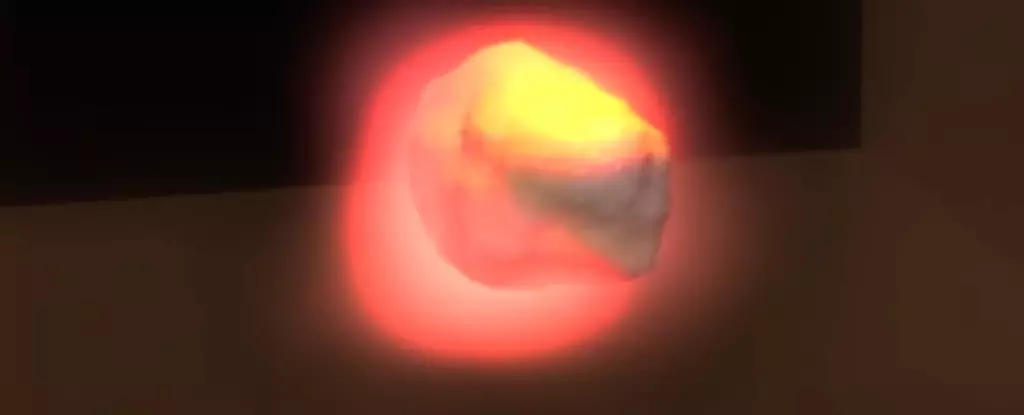NASA’s Curiosity rover has made waves in the scientific community with the groundbreaking detection of the largest organic molecules yet found on Mars. This revelation stands as a monumental stride in our quest to uncover the tantalizing possibility of life beyond Earth. Given the terrestrial context for organic molecules, particularly those like long-chain hydrocarbons that are integral to biological systems, their discovery raises vital questions about the planet’s past and its potential to harbor life forms.
At the heart of this discovery are large organic compounds that could represent remnants of fatty acids—key components of biological structures. On Earth, these carbon-based molecules serve critical roles, especially in the membranes that envelop living cells. This finding could suggest that if microbial life once thrived on the Martian surface, these organic fragments are indicative of its existence. However, the challenge lies in the fact that definitive proof remains elusive, as microbes are minuscule and their intricate details are hard to discern under current technological limitations.
Unearthing Ancient Evidence
The organic molecules were unearthed from a 3.7 billion-year-old rock formation known as Cumberland, located in the Gale Crater’s Yellowknife Bay—an area that bears striking geological resemblances to ancient lakebeds on Earth. The Mars rover employed its Sample Analysis at Mars (SAM) instrument in this pursuit, initially targeting amino acids—building blocks of proteins that signify life. However, the discovery of hydrocarbons such as decane and dodecane, which contain multiple carbon and hydrogen atoms, adds another layer of excitement and complexity to the search for life.
These hydrocarbons can be classified as alkanes, which form the foundational structure of various compounds crucial in biological processes. The unexpected presence of these hydrocarbons hints at ancient microbial activity or, at the very least, environmental conditions conducive to life.
The Path Forward: Mars Sample Return Mission
The hope to further investigate these findings lies in the ambitious Mars Sample Return mission, a collaboration between NASA and the European Space Agency. This mission aims to retrieve rock samples that Perseverance has collected and return them to Earth for in-depth analysis using advanced lab techniques unavailable on Mars. This endeavor holds the potential to decisively determine whether these long-chain organic molecules are indeed signs of ancient life, or merely the products of abiotic processes.
However, the road to executing this mission hasn’t been without hurdles. A recent independent review board raised concerns regarding the increasing budget for the Mars Sample Return project, leading to a reassessment of how the mission might be executed. The prospect of refining this mission is critical, as it could ultimately determine our ability to confirm or deny the existence of past life on the Red Planet.
Implications for Astrobiology
The implications of these discoveries extend far beyond Mars. The organic molecules preserved in Martian rock serve as crucial evidence toward understanding conditions that may have once been favorable for life. The idea that we can analyze and assess the chemical biosignatures left behind by ancient Martian organisms is a dream scenario for astrobiologists, adding fresh fuel to the search for life elsewhere in our solar system and beyond.
While the research on the organic compounds is promising, it does come with an essential caveat; the origins of these molecules remain a puzzle. They could have emerged through biological processes or as a result of geochemical reactions independent of life. As scientists piece together the origins of these hydrocarbons, a clearer picture of Mars’s habitability may begin to take shape.
The Scientific Journey Continues
Curiosity’s exploration of the Gale Crater is not just a mission; it’s a testament to human resilience and curiosity. The notion that longer-chain organic molecules remain hidden in Martian substrates ignites excitement about what future expeditions might unearth. The prospect that more complex organic formations indicative of life could be present sparks an assertive vision for forthcoming missions and reinforces the importance of continued exploration and study.
The timeline of potential future discoveries is tantalizing, as each new development feeds the imagination and scientific ambition regarding life in the cosmos. The echoes of past Martian conditions, imprinted in its geology, could ultimately provide answers to the profound questions of whether we are alone in the universe. As we stand on the brink of extraordinary discoveries, all eyes will be on Mars and the ongoing efforts to decode the secrets it has guarded for millennia.


Leave a Reply